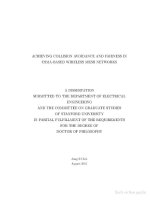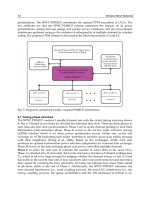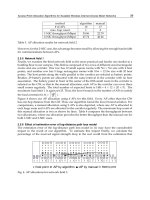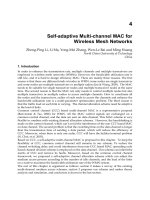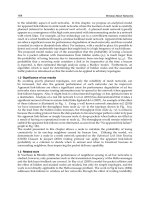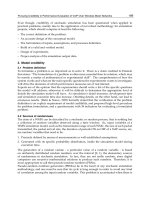WIRELESS MESH NETWORKS – EFFICIENT LINK SCHEDULING, CHANNEL ASSIGNMENT AND NETWORK PLANNING STRATEGIES pptx
Bạn đang xem bản rút gọn của tài liệu. Xem và tải ngay bản đầy đủ của tài liệu tại đây (6.26 MB, 260 trang )
WIRELESS MESH
NETWORKS – EFFICIENT
LINK SCHEDULING,
CHANNEL ASSIGNMENT
AND NETWORK PLANNING
STRATEGIES
Edited by Andrey V. Krendzel
Wireless Mesh Networks – Efficient Link Scheduling,
Channel Assignment and Network Planning Strategies
Edited by Andrey V. Krendzel
Contributors
Vahid Sattari Naeini, Naser Movahhedinia, Gustavo Vejarano, Aizaz U. Chaudhry,
Roshdy H.M. Hafez, Stefan Pollak, Vladimir Wieser, Fawaz Bokhari, Gergely Záruba,
Sangsu Jung, Thomas Olwal, Moshe Masonta, Fisseha Mekuria, Kobus Roux,
Doug Kuhlman, Ryan Moriarty, Tony Braskich, Steve Emeott, Mahesh Tripunitara,
Svilen Ivanov, Edgar Nett, Hassen A. Mogaibel, Mohamed Othman, Shamala Subramaniam and
Nor Asilah Wati Abdul Hamid
Published by InTech
Janeza Trdine 9, 51000 Rijeka, Croatia
Copyright © 2012 InTech
All chapters are Open Access distributed under the Creative Commons Attribution 3.0 license,
which allows users to download, copy and build upon published articles even for commercial
purposes, as long as the author and publisher are properly credited, which ensures maximum
dissemination and a wider impact of our publications. After this work has been published by
InTech, authors have the right to republish it, in whole or part, in any publication of which they
are the author, and to make other personal use of the work. Any republication, referencing or
personal use of the work must explicitly identify the original source.
Notice
Statements and opinions expressed in the chapters are these of the individual contributors and
not necessarily those of the editors or publisher. No responsibility is accepted for the accuracy
of information contained in the published chapters. The publisher assumes no responsibility for
any damage or injury to persons or property arising out of the use of any materials,
instructions, methods or ideas contained in the book.
Publishing Process Manager Tanja Skorupan
Typesetting InTech Prepress, Novi Sad
Cover InTech Design Team
First published July, 2012
Printed in Croatia
A free online edition of this book is available at www.intechopen.com
Additional hard copies can be obtained from
Wireless Mesh Networks – Efficient Link Scheduling,
Channel Assignment and Network Planning Strategies, Edited by Andrey V. Krendzel
p. cm.
ISBN 978-953-51-0672-2
Contents
Preface IX
Section 1 Efficent Link Scheduling and
Channel Assignment Strategies in WMNs 1
Chapter 1 Application of Genetic
Algorithms in Scheduling of TDMA-WMNs 3
Vahid Sattari Naeini and Naser Movahhedinia
Chapter 2 Stability-Based Topology Control
in Wireless Mesh Networks 21
Gustavo Vejarano
Chapter 3 Channel Assignment Using Topology Control
Based on Power Control in Wireless Mesh Networks 47
Aizaz U. Chaudhry and Roshdy H.M. Hafez
Chapter 4 Channel Assignment Schemes
Optimization for Multi-Interface
Wireless Mesh Networks Based on Link Load 79
Stefan Pollak and Vladimir Wieser
Chapter 5 Partially Overlapping Channel
Assignments in Wireless Mesh Networks 103
Fawaz Bokhari and Gergely Záruba
Section 2 Network Planning Aspects in WMNs 131
Chapter 6 Autonomous Traffic Balancing
Routing in Wireless Mesh Networks 133
Sangsu Jung
Chapter 7 Achievable Capacity Limit of
High Performance Nodes for Wireless Mesh Networks 149
Thomas Olwal, Moshe Masonta,
Fisseha Mekuria and Kobus Roux
VI Contents
Chapter 8 A Correctness Proof of a Mesh Security Architecture 177
Doug Kuhlman, Ryan Moriarty,
Tony Braskich, Steve Emeott and Mahesh Tripunitara
Chapter 9 Achieving Fault-Tolerant Network
Topology in Wireless Mesh Networks 203
Svilen Ivanov and Edgar Nett
Chapter 10 High Throughput Path Establishment for
Common Traffic in Wireless Mesh Networks 227
Hassen A. Mogaibel, Mohamed Othman,
Shamala Subramaniam and Nor Asilah Wati Abdul Hamid
Preface
Wireless mesh networks (WMNs) have recently received a great deal of attention as a
promising cost-effective solution to provide coverage and broadband wireless
connectivity for mobile users to get access to different IP applications and services.
The factor that has helped WMNs become attractive is the wide application prospects
from the wireless community, home and enterprise networking. Moreover, wireless
mesh technologies are becoming more and more popular in the context of their
integration with heterogeneous next generation networks for purposes of backhaul
support, traffic offloading, load balancing, fixed-mobile convergence, etc.
However, making these WMNs operationally efficient is a challenging task. In recent
years, there has been a lot of work on research issues. Nevertheless, there still exist
some open research challenges related to link scheduling, channel assignment, routing
and other network planning issues in multi-radio multi-channel WMNs. The main
objective of this book is to highlight some recent efforts in developing novel efficient
design strategies and efficient algorithms to significantly improve performance and
functionality of WMNs. The results presented in this book are expected to help in
taking design decisions when deploying WMNs.
Ten contributed chapters written by a group of well-known experts in wireless mesh
networking are arranged in two sections.
Section 1 focuses on link scheduling schemes to select a subset of links for simultaneous
transitions under interference constraints in an efficient and fair manner to guarantee a
certain level of network connectivity. Besides, it describes channel assignment strategies
to improve the network throughput in multi-radio multi-channel WMNs by means of an
efficient channel utilization and minimization of the interference. Chapter 1 of this
section describes a framework for fair link scheduling based on the application of genetic
algorithms taking into account both the QoS requirements of data flows between mesh
clients and underlying network characteristics affecting the overall system performance.
Chapter 2 deals with the stability-based topology control mechanism using the
underlying link scheduling policy of WMNs to optimize the ability of links to carry the
information transported by end-to-end data flows. Chapter 3 introduces a topology-
controlled interference-aware channel assignment algorithm based on power control
which intelligently assigns the available non-overlapping frequency channels to the
X Preface
wireless mesh routers with the objective of minimizing interference to improve network
throughput. Chapter 4 discusses the optimal number of radio interfaces for wireless
mesh routers depending on the topology of the mesh network (grid or random), the
number of network nodes and the number of data flows in the network. Chapter 5 takes
an in-depth look into recent channel assignment schemes exploiting partially
overlapping channels in the context of multiple radio WMNs.
Section 2 addresses some important network planning issues related to efficient routing
protocols in dynamic large-scale mesh environment, achievable capacity limit of a single
wireless link between two multi-interface mesh nodes, the correctness of the mesh
security architecture, fault-tolerant mesh network topology planning. Chapter 6 of the
section presents an autonomous traffic balancing routing protocol based on a combination
of back-pressure and geographic routing schemes. The proposed mechanism is inspired
by the electrostatic potential theory and able to react adaptively to dynamic traffic
environment in large-scale WMNs with a low routing overhead. Chapter 7 presents an in-
depth analysis of the impact of multipath and MIMO fading channels on achievable
theoretical capacity limits of single links connecting mesh nodes and the impact of
number of interfaces and channels per each mesh node on the end-to-end capacity limits
of wireless broadband mesh networks. The capacity limits provide useful inputs towards
an optimal design of cross-layer protocols. Chapter 8 examines correctness of the mesh
security architecture using a protocol composition logic to prove security of the IEEE
802.11s protocol suite. Chapter 9 deals with a fault-tolerance method for guaranteeing the
availability of radio coverage and connectivity of wireless mesh networks in dynamic
propagation environment. It also proposes an automatic mesh router planning algorithm,
which finds a minimum number of wireless mesh routers and their positions to restore
the fault-tolerant network mesh topology. Chapter 10 describes a channel reservation
scheme in combination with an on-demand routing protocol to establish high throughput
paths in multi-radio multi-channel environments and reduce the intra/inter flow
interference for the traffic going towards the mesh gateways.
Thus, this book covers a variety of issues related to link scheduling, channel
assignment, routing and network planning in WMNs and provides an in-depth look
into recent advances in these topics. The book can be useful for researchers, PhD
students, engineers, and practitioners that are interested in wireless mesh networking.
I wish to express my deep appreciation to all Authors for their thorough work. Special
thanks to Ms. Tanja Skorupan, Publishing Process manager at InTech Open Access
Publisher, for her kind cooperation and patience during the preparation of this book. I
wish also to thank my colleagues, Marc Portoles, José Nuñez, and Josep Mangues, for
their encouragement and continuous support.
Andrey V. Krendzel
Centre Tecnològic de Telecomunicacions de Catalunya (CTTC), Barcelona,
Spain
Section 1
Efficent Link Scheduling and
Channel Assignment Strategies in WMNs
Chapter 1
© 2012 Naeini and Movahhedinia, licensee InTech. This is an open access chapter distributed under the
terms of the Creative Commons Attribution License ( which
permits unrestricted use, distribution, and reproduction in any medium, provided the original work is
properly cited.
Application of Genetic
Algorithms in Scheduling of TDMA-WMNs
Vahid Sattari Naeini and Naser Movahhedinia
Additional information is available at the end of the chapter
1. Introduction
WMN (Wireless Mesh Network) is usually built on fixed stations and interconnected via
wireless links to form a multi-hop network. Typical and inexpensive deployment of WMNs
use some MSSs (Mesh Subscriber Station) and one MBS (Mesh Base Station), where their
multi-hop feature can be utilized to increase their range of accessibility in rural areas effec-
tively. Moreover, since they are dynamically self-organized and self-configuring, these net-
works turn to be more reliable.
TDMA-WMN (Time Division Multiple Access-WMN) is a special WMN which has some
special features: TDM (Time Division Multiplexing) is adopted between MSSs and the MBS
to access the air interface; frames are defined and divided into some equal duration sub-
frames to provide better timing and synchronization to MSSs. As these subframes (called
transmission opportunities) are taken by MSSs to transmit packets on unidirectional links,
it’s more preferable to schedule each link rather than each node connection.
Four sources of interference are defined in TDMA-WMNs:
- Transmitter-Transmitter: each node can’t receive data flows from more than one source.
- Receiver-Receiver: each node can’t send data flows to more than one destination.
- Transmitter-Receiver: each node can’t receive and transmit simultaneously.
- Transmitter-Receiver-Transmitter: two sources can’t transmit at the same time while the
transmitter and the receiver share a neighbor which can hear both transmissions. For
example, in Figure 1 where the two conflicting links (e
1 and e7) are shown with bold
lines, nodes cannot transmit simultaneously as they share the same neighbor (Node 2)
which can here both transmissions.
The first three sources of interference are known as first hop conflict (primary conflicts) and
the fourth one is knows as second hop conflict (secondary conflicts). Second hop conflict is
disregarded in most of the presented works [1], [2].
Wireless Mesh Networks – Efficient Link Scheduling, Channel Assignment and Network Planning Strategies
4
1 2
3
5
e4
e6
e2
e1
e3
e5
6
e7
e8
Figure 1. A TDMA-WMN with its conflicting links
A major challenge in WMNs is to provide QoS support and fair rate allocation among data
flows. Almost all of the routing and scheduling algorithms presented in the literature have
one common weak point: when the MBS collects requests larger than the frame length from
all the MSSs, these algorithms shrink link durations to fit in the frames. Scaling down the
link durations may cause some drawbacks in guaranteeing the QoS requirements of voice
and video traffic. Two schemes can be exploited to overcome this problem: 1) A call admis-
sion control mechanism can be deployed to avoid link duration shrinkage; 2) A new sched-
uling method may be proposed to schedule the packets received from the underlying net-
work. In this chapter we focus on the second solution with respect to the first solution.
Scheduling in WMNs is divided in two categories: centralized and distributed scheduling.
In centralized scheduling, there exists one MBS and the other stations (MSSs) relay packets
of other stations to/from end points (in this chapter we call these end points as MTs, while
MSSs assume to be fixed). The main purpose of this chapter is related to centralized
scheduling and admission control.
On the other hand, rapid growth of wireless networks has commenced challenging issues in
co-deployment of various technologies including WiFi, WiMAX. While WiFi networks are
very popular for providing data services to Internet users in LAN environments, WiMAX
technology has been adopted for MAN networks to provide urban accessibility to hot spots
or end users. These two technologies seem to be competitors; however, they can interwork
to gain metro-networks performance, cost effectiveness and coverage area. This configura-
tion can be used in TDMA-WMNs, however when the same frequency band is employed
with different network elements (e.g., the U-NII frequency at 5GHz may be shared among
IEEE 802.16d and IEEE 802.11a or IEEE 802.11n), more complex strategies are required for
scheduling and packet translation from one technology to another.
In this chapter, with respect to the interoperability of WiFi and TDMA-WMNs networks, we
develop a scheduling and admission control mechanism among data flows such that the
QoS requirements of delay sensitive traffic types can be provisioned and elastic traffic types
get a fair duration of bandwidth.
Application of Genetic Algorithms in Scheduling of TDMA-WMNs
5
To provide QoS support for delay sensitive traffic over WiFi, IEEE 802.11e introduces two
types of channel access methods: EDCA (Enhanced Distributed Channel Access) and HCCA
(Hybrid Coordination Channel Access). Since the HCCA function deployed in the MTs is
essentially designed to meet the negotiated QoS requirements of admitted flows, we apply
this function to the WiFi network [3], [4].
The chapter is organized as follows: in sections 2, some research activities in scheduling
mechanisms in WMNs and IEEE 802.11 are summarized. In section 3, we introduce an
overview of IEEE 802.16 and IEEE 802.11(e) standards. QoS comparison between IEEE
802.11 and IEEE 802.16 mesh modes are described in this section. Fourth section is devoted
to describe the system model. In this section we introduce the basic assumptions of the
system and formally describe the system. In fifth section, the genetic algorithm is briefly
described and its application to our problem is discussed. The proposed method is
evaluated using simulation results in section 6. Finally, conclusions are drawn in seventh
section.
2. Related works
Centralized scheduling mechanism in WMNs has been investigated in [1], [2], [5]-[10], [32-
33]. Most of the research activities in this area are not suitable for TDMA mesh networks
(e.g., IEEE 802.16d). They consider only primary conflicts in which the connections share a
neighbor, while TDMA-WMN is faced with secondary conflicts where the transmitter and
the receiver share a neighbor, which can hear both transmissions.
The main algorithm in IEEE 802.16d finds a link ranking during a breath-first traversal of
the routing tree. This algorithm has no idea for spatial reuse in the network. Spatial reuse in
these networks has been investigated in [5], [7]-[10]. Ref. [9] uses Transmission-Tree
Scheduling (TTS) algorithm that is based on graph coloring. This algorithm don’t consider
the protocol overhead of TDMA scheduling. While [10] uses the load-balancing algorithm to
increase spatial reuse, [8] considers Bellman-Ford method for both spatial reuse and
minimum TDMA delay. These schemes don’t take into account the underlying network
behavior which can affect scheduling of traffic flows of other MSSs. On the other hand, these
algorithms shrink the link duration when the frame is short for scheduling the links.
Application of intelligent scheduling methods in wireless mesh networks has been inspired
by the fact that finding a schedule in TDMA scheduling is NP-complete [11]. Ref. [12] uses
fuzzy hopfield neural network technique to solve the TDMA broadcast scheduling problem
in wireless sensor networks. Artificial neural network with reinforcement learning has been
introduced in [13] to schedule downlink traffic of wireless networks. A genetic algorithm
approach is used in [2] to find the schedule related to each link in a WMN. Here again, their
scheduling method merely considers the traffic flown on the links; however, how these links
empty their queues has not been elaborated.
None of the above research activities, consider neither the underling network behavior nor
the types of traffic streams flown on the links. Our system model is different from the
Wireless Mesh Networks – Efficient Link Scheduling, Channel Assignment and Network Planning Strategies
6
previous works in two aspects. First, we take into account the underlying network traffic
related to each MSS. Second, the algorithm proposed in this chapter is such that shrinking
the link duration doesn’t affect the minimum QoS requirements of real-time traffic types.
3. IEEE 802.16 and IEEE 802.11e: An overview
3.1. Overview of IEEE 802.11e
The multiple access mechanism in 802.11e is arisen in super-frames which start with beacon
frames having the same duration as beacon intervals. The super-frame comprises an
optional CFP (Contention Free Period) followed by a CP (Contention Period) divided into
equal duration SIs as shown in Figure 2. At each SI (Service Interval), each QSTA (QoS
Station) should transmit its own traffic streams with respect to its QoS constraints. This
mechanism is called HCCA function which defines a centrally-controlled polling-based
medium access scheme for IEEE 802.11e WLANs. Each SI is divided into a CAP (Controlled
Access Phase) period and an optional EDCA period in which the traffic streams having less
stringent QoS constraints contend for access to the medium. Usually best effort traffic
streams such as HTTP use this period which offers no QoS guarantee. The CAP period is
further divided into a number of TXOPs (Transmission Opportunity). Each TXOP is granted
by QAP (QoS Access Point) to each QSTA and each QSTA is responsible for sharing this
period among its traffic streams.
Figure 2. HCF super-frame structure
3.2. Overview of IEEE 802.16 mesh mode
IEEE 802.16 MAC PDUs (Protocol Data Unit) (Figure 3) begin with a fixed-length generic
MAC header (6 bytes). The MAC header field contains a 2 bytes CID (Connection Identifier)
field which carries 8 bits Link ID used for addressing nodes in the local neighborhood. The
header is followed by the Mesh sub-header (2 bytes) which includes Xmt Node Id. Mesh BS
grants Node Ids to candidate nodes when authorized to the network. After the variable
length payload there exists a 4 bytes CRC. The medium in IEEE 802.16 mesh mode is
divided into equal duration frames (Figure 4), consisting of two sub-frames:
Data sub-frame,
Control sub-frame.
Application of Genetic Algorithms in Scheduling of TDMA-WMNs
7
The control sub-frame is divided into MSH-CTRL-LEN transmission opportunities indicated
in the ND (Network Descriptor). Each transmission opportunity comprises 7 OFDM
symbols, so the length of the control sub-frame is fixed and equal to 7×MSH-CTRL-LEN
OFDM symbols.
Figure 3. MAC PDU format
Figure 4. Frame structure for the mesh mode
Nodes can transmit based on the granted bandwidth and a transmission schedule which is
worked out using a common distributed algorithm. The data sub-frame is used for this
purpose which is divided into transmission opportunities comprising 256 mini-slots based
on the standard. However, there may be fewer than 256 mini-slots depending on the frame
size and the size of the control sub-frame. Frame duration which is indicated in ND is
determined by MBS to avoid losing synchronization with the connecting nodes. MSH-
CSCH-DATA-FRACTION indicated in ND specifies the fraction of data sub-frame which
can be used for centralized scheduling. The remaining part of the data sub-frame is used for
decentralized scheduling.
3.3. QoS Comparison between WiFi and WiMAX mesh mode
Providing QoS in IEEE 802.11e comes with a new coordination function called HCF. The
HCF controlled channel access is for the parameterized QoS, which provides the QoS based
on the contract between the AP and the corresponding QSTA(s). First, a traffic stream is
established between the AP and an QSTA. A set of traffic characteristics and QoS require-
ment parameters are negotiated between the AP and QSTA and the traffic stream should be
admitted by the AP. The QoS control field in the MAC frame format is a 16 bits field which
facilitates the description of QoS requirements of application flows. Its TID (4 bits) identifies
the TC (0-7) or the TS (8-15) to which the corresponding MSDU in the FB field belongs. The
last eight bits are used usually by QAP to receive the queue size of QSTAs. After admission,
the AP specifies the TXOP duration for the QSTA based on the traffic characteristics. So, the
QoS is provided based on connections established between AP and QSTA(s).
Unlike WiFi, the QoS in the mesh mode of IEEE 802.16 is provided in a packet by packet
basis. Each transmitted packet contains the mesh CID. Figure 5 shows the structure of mesh
CID used in unicast messages. In order to enable differentiated handling of packets, the
queuing and forwarding mechanisms deployed at individual nodes may make use of the
values for the Type, Reliability, Priority/Class, and Drop Precedence fields. The Type field is
used to distinguish between different categories of messages. This field may be used to
Wireless Mesh Networks – Efficient Link Scheduling, Channel Assignment and Network Planning Strategies
8
prioritize the transmission of management messages transmitted in the data sub-frame (e.g.,
messages for uncoordinated distributed scheduling). The Reliability field is employed to
specify unacknowledged transmitted packets (when ARQ is enabled). This allows the packet
to be retransmitted for up to four times. The Priority/Class field allows the classification of
the messages into eight priority classes. This can be used by the queuing and forwarding
mechanisms at each node to differentiate the packet treatment for different classes. The Drop
Precedence field indicates the likelihood of a packet being dropped during congestion.
Figure 5. Mesh CID format
4. System model
SSHC stationary end nodes (Figure 6) are able to communicate from one side with MTs and
from the other side with MSSs or MBS via their PHY layers in both sides. In the following
subsections we develop a genetic based system for scheduling the packets waiting in the
SSHCs queues.
Figure 6. Topology of the scenario
4.1. Basic assumptions
In this chapter we consider a WMN with one MBS and some MSSs (Figure 6). We consider
access traffic in the mesh network, so the routes of the traffic form a binary tree rooted at the
MBS. MSSs relay numerous traffic types (data, voice or video) between their MTs and other
Application of Genetic Algorithms in Scheduling of TDMA-WMNs
9
MSSs or the MBS. The MBS, MSSs, and MTs share the same frequency band. The routing
tree that is made by the MBS is a binary tree [14], and we assume that it’s known in
advanced.
For better support of QoS, we consider MBS and MSSs use TDMA-based scheduling in their
MAC layer; however, because of IEEE 802.11 deployment in most mobile devices (laptops
and cell phones), MTs use contention-based medium access method. In a given TDMA
frame (of the length for example 20ms), some MSSs are sending frames upward or down-
ward the network, while the others are collecting (distributing) frames from (to) MTs. Since
the tree rooted at the MBS is a binary one, each MSS has maximum of six logical links to its
neighbor MSSs; three for sending and another three for receiving packets (Figure 1). As
wireless transceivers are usually half duplex [8], they can’t be used for reception and trans-
mission at the same time. So there are six queues in each MSS, three of these are to store the
outbound packets and three others are for inbound packets to queue for reception. Howev-
er, in our model receiving queues are ignored as they are considered in sending nodes;
hence at most three queues are considered for scheduling. It’s worthy to note that we
schedule only one queue at each leaf node and two queues at the MBS. Moreover we sched-
ule only the links that have non-empty queues. Each queue is filled by MTs (shown in Fig-
ure 6) or the receiving links at that node. For example in Figure 1, the queue of e
2 can be
filled by the queue of e
4.
Let, M be the set of all the stations (including MSSs and the MBS) in the system, indexed by
m=1,2,…,M. We consider M>1; i.e., there is at least one MSS. In most of the mesh networks,
the frame length is fixed and may not be changed; otherwise the whole system should be
restarted [8]; hence the frame length is fixed at L milliseconds. Each transmission in the
frame is along with some overheads, so the number of transmissions for each link should be
limited to one per frame to minimize transmission overhead.
Let
be the set of all the links in the system. We take a subset I of (I⊂) , in which the
links have non empty queues. Each i∈I has one queue per traffic type which are assumed to
have unlimited sizes for the sake of simplicity.
Each queue has some restricted QoS traffic specifications; this means that each queue should
be scheduled appropriately and get emptied in a desired time. Since the frame length is
fixed and all of the links in the system should be scheduled at each frame (because of their
restricted QoS requirements), there is a limited interval for each queue to get scheduled.
Nevertheless, some of the nodes may not find enough transmission opportunity to evacuate
all of their queues, causing the system not to be able to fulfill QoS constraints of delay sensi-
tive traffic types. So, a scheduling method is strongly necessary to satisfy QoS requirements
of voice and video traffic. On the other hand, bandwidth allocation to more stringent QoS
traffic types may cause starvation for elastic traffic. As such, we define a threshold (k), to
assure the elastic traffic types to be scheduled at each k frames.
Let k
m,i,j be the length of the jth queue (filled by MTs or other MSSs), associated with ith
outgoing link, related to mth MSS. So, [k
m,i,j] is an M × I × J matrix. Each queue should be
Wireless Mesh Networks – Efficient Link Scheduling, Channel Assignment and Network Planning Strategies
10
scheduled to transmit its packets over the appropriate link based on the QoS requirements
of its content.
[km,i,j] is available at the MBS through some control messages. Assuming that a 64Kbps voice
stream should be serviced in each frame, it generates a 160 bytes packet which is to be
transmitted in each 20ms frame. In case of a video traffic stream, its packets should be
scheduled every two frames [15].
Some of the main parameters of each traffic type in the system are as follows [16]:
Delay Bound (D): Maximum amount of time allowed (including queuing delay) to
transmit a frame across the wireless interface.
Mean Data Rate (ρ): Average bit rate at the MAC layer required for the packet
transmissions.
Nominal Packet Size (L): Average packet size.
Maximum Packet Size (M): Maximum packet size.
Minimum Service Interval (mSI): Minimum interval between the start of successive
service period.
Maximum Service Interval (MSI): Maximum interval between the start of successive
service period.
Next, we describe the formal formulation of our system.
4.2. Problem formulation
Each queue is scheduled once in each frame. We assume that spatial reuse is deployed in the
routing algorithm, so:
∑∑∑
,,
≥,∀ =, =1,2,3,…
∈∈∈
(1)
Where Tr is the data transferred from the queue j in the current frame, associated with ith
outgoing link, related to mth MSS. L is the length of the frame and F is a parameter that
specifies the scheduling duration which is a sub-multiple of L. The above inequality means
that due to spatial reuse mechanism applied to the system, the number of transmissions may
exceed the frame length.
At the end of each frame, the remaining number of packets in all of the queues should be
minimized:
min
∑∑∑
..
∈
−
∑∑∑
,,
∈∈∈∈∈
,∀= (2)
In the above minimization problem, K specifies the number of residual packets waiting in
the queue for scheduling. We assume three different queues (e.g., CBR, VBR, and elastic
traffic) for each link with higher priorities indexed by lower numbers. The following con-
straints are applied on queue depletions:
,,
>0,∀= (3)
Application of Genetic Algorithms in Scheduling of TDMA-WMNs
11
,,
>0,∀= (4)
,,
>0,∀= (5)
,,
>
,,
∧
,,
>
,,
∧
,,
>
,,
∀ = (6)
Inequality (3) means that the first queue should be scheduled in every k frame. Two other
inequalities state that their related queues may be scheduled in every k frame optionally.
Inequality (6) demonstrates that the priority of the first queue is higher than the second one
and the second queue is more prior than the third one.
The minimization problem (2) with its constraints (1), (3), (4), (5), and (6) are such that they
can’t be solved by simple mathematics; since the problem shown to be NP-complete [11].
Heuristic solutions might work in certain cases, but they fail to adapt to different network
scenarios [2].
The above optimization problem can be bounded and reformulated such that speed conver-
gence can be obtained as described in the following sentences. As the first queue is reserved
for CBR traffic streams, the second queue is reserved for VBR traffic streams, and third one
is reserved for elastic (ABR) traffic type, then the first queue should be serviced in each
frame, and the second one should be services in every two frames [15]. After that, the re-
maining bandwidth (if any) is considered for the third queue. Available bandwidth should
be fairly shared among the queues. For this purpose, we take advantage of a threshold (k) to
force the scheduler to take a minimum percent of the available bandwidth for elastic data
types. This causes a fair scheduling method for elastic traffic types and will be presented in
the simulation results. Now we have the following optimization problem with its condi-
tions. It can be seen from the minimization problem (7) that the number of queues per each
link and the number of links per each node is bounded on 3 (as discussed earlier); so the
search space is limited and convergence to the termination conditions will be faster than the
previous problem (2).
min
∑∑∑
,,
−
∑∑∑
,,
, >2 (7)
Subject to:
∑∑∑
,,
≥ (8)
,,
>0 (9)
,,
>0 (10)
,,
>0,>2 (11)
,,
>0∨
,,
>0∨
,,
>0,>2 (12)
Wireless Mesh Networks – Efficient Link Scheduling, Channel Assignment and Network Planning Strategies
12
4.3. Admission control
The CBR queue should be emptied at the end of its schedule or the backlogged packets are
to be dropped. So, the new connection should be rejected if the following equation is not
satisfied:
,,
−
.,
=0∈,∈ (13)
While the VBR queue get filled in different intervals, we put a threshold on the top of its
queue. If the number of the packets available in the queue is greater than this threshold,
then any new call will be rejected. So:
,,
−
.,
<
∈,∈ (14)
The elastic traffic queue can be filled every time a packet is generated, but may cause
undesirable delay, so, we impose a threshold (
τ
2) on the third queue as well. However
τ
2
should be greater than
τ
1, since elastic data types have lighter QoS constraints than VBR
data types.
,,
−
.,
<
>2,∈,∈ (15)
5. Application of genetic algorithm in scheduling of SSHCs queues
In the following subsections we first present an overview of genetic algorithm, and then we
develop a GA-based scheduling mechanism for the problem.
5.1. Genetic algorithm: An overview
The genetic algorithm is a search heuristic that mimics the process of natural evolution. This
heuristic is routinely used to generate useful solutions to optimization problems. Genetic
algorithms belong to the larger class of evolutionary algorithms, which generate solutions to
optimization problems using techniques inspired by natural evolution, such as inheritance,
mutation, selection, and crossover [17], [18].
In a genetic algorithm, a population of strings (called chromosomes or the genotype of the
genome), which encode candidate solutions (called individuals, creatures, or phenotypes) to
an optimization problem, evolves toward better solutions. An initial population is created
from a random selection of solutions (which are analogous to chromosomes). A value for
fitness is assigned to each solution (chromosome) depending on how close it actually is to
solve the problem and arrive to the answer of the problem. Those chromosomes with higher
fitness values are more likely to reproduce offspring. The offspring is a product of the father
and mother, whose composition consists of a combination of genes from them (this process
is known as crossing over). This generational process is repeated until a termination condi-
tion has been reached. Common terminating conditions are:
A solution is found that satisfies minimum criteria.
Fixed number of generations reached.
Application of Genetic Algorithms in Scheduling of TDMA-WMNs
13
The highest ranking solution's fitness is reaching or has reached a plateau such that
successive iterations no longer produce better results.
Manual inspection
Combinations of the above.
At each stage, crossover and mutation genetic operators may be applied to the new strings.
Crossover is a genetic operator that combines two chromosomes (parents) to produce a new
chromosome (offspring). The idea behind crossover is that the new chromosome may be
better than both of the parents if it takes the best characteristics from each of the parents.
As an example, suppose there are two chromosomes 1 and 2 which are represented as a
binary string, the most used way of encoding a chromosome, as the following:
Chromosome 1 1101100100110110
Chromosome 2 1101111000011110
Crossover selects genes from parent chromosomes and creates a new offspring. The simplest
way how to do this is to choose randomly some crossover point and everything before this
point copy from the first parent and everything after the crossover point copy from the
second parent. | is the crossover point. The following shows this process:
Chromosome 1 11011 | 00100110110
Chromosome 2 11011 | 11000011110
Offspring 1 11011 | 11000011110
Offspring 2 11011 | 00100110110
After performing the crossover, mutation is used to maintain genetic diversity from one
generation of population chromosomes to the next. It introduces some local modifications of
the individuals in the current population on order to explore new possible solutions. For
binary encoding of chromosome, we can switch a few randomly chosen bits from 1 to 0 or
from 0 to 1. For our example, the mutation process is shown as the following:
Original offspring 1 1101111000011110
Original offspring 1 1101100100110110
Mutated offspring 1 1100111000011110
Mutated offspring 2 1101101100110110
The pseudo-code of a basic GA is summarized as follows:
1. Choose the initial population of individuals
2. Evaluate the fitness of each individual in that population
3. Repeat on this generation until termination: (time limit, sufficient fitness achieved, etc.)
i. Select the best-fit individuals for reproduction.
ii. Breed new individuals through crossover and mutation operations to give birth to
offspring.
iii. Evaluate the individual fitness for new individuals.
iv. Replace least-fit population with new individuals.



